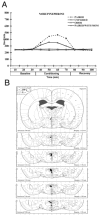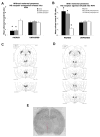Maternal attenuation of hypothalamic paraventricular nucleus norepinephrine switches avoidance learning to preference learning in preweanling rat pups
- PMID: 17675020
- PMCID: PMC2659450
- DOI: 10.1016/j.yhbeh.2007.06.004
Maternal attenuation of hypothalamic paraventricular nucleus norepinephrine switches avoidance learning to preference learning in preweanling rat pups
Abstract
Infant rats learn to prefer stimuli paired with pain, presumably due to the importance of learning to prefer the caregiver to receive protection and food. With maturity, a more 'adult-like' learning system emerges that includes the amygdala and avoidance/fear learning. The attachment and 'adult-like' systems appear to co-exist in older pups with maternal presence engaging the attachment system by lowering corticosterone (CORT). Specifically, odor-shock conditioning (11 odor-0.5 mA shock trials) in 12-day-old pups results in an odor aversion, although an odor preference is learned if the mother is present during conditioning. Here, we propose a mechanism to explain pups ability to 'switch' between the dual learning systems by exploring the effect of maternal presence on hypothalamic paraventricular nucleus (PVN) neural activity, norepinephrine (NE) levels and learning. Maternal presence attenuates both PVN neural activity and PVN NE levels during odor-shock conditioning. Intra-PVN NE receptor antagonist infusion blocked the odor aversion learning with maternal absence, while intra-PVN NE receptor agonist infusion permitted odor aversion learning with maternal presence. These data suggest maternal control over pup learning acts through attenuation of PVN NE to reduce the CORT required for pup odor aversion learning. Moreover, these data also represent pups' continued maternal dependence for nursing, while enabling aversion learning outside the nest to prepare for pups future independent living.
Figures





Similar articles
-
Early-life stress disrupts attachment learning: the role of amygdala corticosterone, locus ceruleus corticotropin releasing hormone, and olfactory bulb norepinephrine.J Neurosci. 2009 Dec 16;29(50):15745-55. doi: 10.1523/JNEUROSCI.4106-09.2009. J Neurosci. 2009. PMID: 20016090 Free PMC article.
-
Dual circuitry for odor-shock conditioning during infancy: corticosterone switches between fear and attraction via amygdala.J Neurosci. 2006 Jun 21;26(25):6737-48. doi: 10.1523/JNEUROSCI.0499-06.2006. J Neurosci. 2006. PMID: 16793881 Free PMC article.
-
Defining age limits of the sensitive period for attachment learning in rat pups.Dev Psychobiol. 2010 Jul;52(5):453-64. doi: 10.1002/dev.20448. Dev Psychobiol. 2010. PMID: 20583142 Free PMC article.
-
Rodent model of infant attachment learning and stress.Dev Psychobiol. 2010 Nov;52(7):651-60. doi: 10.1002/dev.20482. Dev Psychobiol. 2010. PMID: 20730787 Free PMC article. Review.
-
The development and neurobiology of infant attachment and fear.Dev Neurosci. 2012;34(2-3):101-14. doi: 10.1159/000336732. Epub 2012 May 8. Dev Neurosci. 2012. PMID: 22571921 Free PMC article. Review.
Cited by
-
Intact maternal buffering of stress response in infant rats despite altered responsivity towards maternal olfactory cues in the valproic acid model of autism-like behavior.Front Behav Neurosci. 2022 Aug 22;16:959485. doi: 10.3389/fnbeh.2022.959485. eCollection 2022. Front Behav Neurosci. 2022. PMID: 36072089 Free PMC article.
-
Developmental transitions in amygdala PKC isoforms and AMPA receptor expression associated with threat memory in infant rats.Sci Rep. 2018 Oct 2;8(1):14679. doi: 10.1038/s41598-018-32762-y. Sci Rep. 2018. PMID: 30279521 Free PMC article.
-
Rodent models of early adversity: Impacts on developing social behavior circuitry and clinical implications.Front Behav Neurosci. 2022 Aug 4;16:918862. doi: 10.3389/fnbeh.2022.918862. eCollection 2022. Front Behav Neurosci. 2022. PMID: 35990728 Free PMC article. Review.
-
Impact of prolonged chronic social isolation stress on behavior and multifractal complexity of metabolic rate in Octodon degus.Front Behav Neurosci. 2023 Oct 20;17:1239157. doi: 10.3389/fnbeh.2023.1239157. eCollection 2023. Front Behav Neurosci. 2023. PMID: 37928446 Free PMC article.
-
Dynamic developmental changes in neurotransmitters supporting infant attachment learning.Neurosci Biobehav Rev. 2023 Aug;151:105249. doi: 10.1016/j.neubiorev.2023.105249. Epub 2023 May 29. Neurosci Biobehav Rev. 2023. PMID: 37257712 Free PMC article. Review.
References
-
- Barr GA. Ontogeny of nociception and antinociception. NIDA Res Monograph. 1995;158:172–201. - PubMed
-
- Bialik RJ, Pappas BA, Roberts DC. Neonatal 6-hydroxydopamine prevents adaptation to chemical disruption of the pituitary-adrenal system in the rat. Horm Behav. 1984;18:12–21. - PubMed
-
- Camp LL, Rudy JW. Changes in the categorization of appetitive and aversive events during postnatal development of the rat. Dev Psychobiol. 1988;21:25–42. - PubMed
-
- Chen XQ, Du JZ, Wang YS. Regulation of hypoxia-induced release of corticotropin-releasing factor in the rat hypothalamus by norepinephrine. Regul Pept. 2004;113:221–228. - PubMed
Publication types
MeSH terms
Substances
Grants and funding
LinkOut - more resources
Full Text Sources

